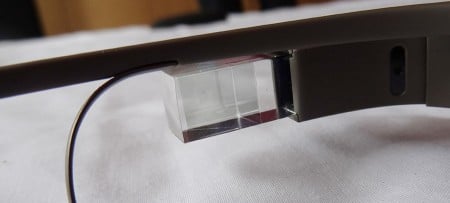The future is coming, if what we’re led to believe is true, and part of that future is companion devices that replace your glasses and wrist watch. While the smart watch is right now the domain of Pebble, Samsung, and Sony, Google has its eyes firmly set on covering your eyes, as we go hands – and eyes – on with Glass.
First announced last year and released only to select US residents, Google Glass is a unique idea designed to help you bring your online world where ever you go without forcing you to pull your smartphone from your pocket and bother it with use.
Most Australians don’t have access yet to the technology, and from what we hear, when it does eventually arrive, it won’t be cheap, possibly grabbing as high as a $1400 price tag for what is essentially a small protector and camera you fit over your eyes.
Regardless, this week GadgetGuy went hands-on with the tech, putting the future on our faces to see just what it was like and if you would use it.

First there’s the tech inside, and what you’re essentially seeing in front of you is a low resolution screen projected onto glass prisms.
The screen will display small amounts of text, maps, images, and can even display full webpages, though we fear people will practically walk into buildings if they start browsing with one eye.
That last part has to be acknowledged, because regardless of which eye you consider your best, Google Glass – at present – displays the image to your right eye, the images shown just beyond that of the eye as if you’re watching a small translucent TV off in the distance.
Still, the image is readable, and this technology works in tandem with your mobile device, a camera, a small touchpad on the side, and a microphone, as well as some bone conduction technology that uses your skull to send audio to your ears and helps to pick up on the things you’re saying.
What you see through Glass is also quite clear, though you can make out the outline of the screen on your right eye, and in some ways, this reminds us of the technology used on 90s gaming systems produced by the likes of Tiger.
Google’s technology is better, without question, but we’re still reminded of devices like the R-Zone, possibly because of the connection to the small eye-covering LCD screens that existed back then.

But this isn’t a toy, and when you use Google Glass, you see that this could be the best extension of your phone yet.
To activate Glass, you merely wake it up by say “ok glass” and then asking it something, such as “get directions to the Opera house” or “Google the temperature in Sydney, Australia.”
With the command received, your phone takes the information, does it voice recognition tricks, and sends that information to both Google Glass and the web, delivering the information as soon as your phone has it.
In a way, it’s like wearing parts of your phone around, and if you live on your smartphone, this is like walking around with part of it strapped to your head.
Other things your smartphone can do have been ported here, including taking photos and dealing with phone calls.
We had no problems with comfort, but we don’t wear glasses, and some of the people we saw on the tour did have problems putting on the glasses comfortably.
It won’t be for everyone, though, and while Google Glass is a neat concept, it’s also an expensive one.
Really, it’s like the smart watch craze, which not everyone completely gets. We love our smart watches, but these come in at a much lower price point than the expected one of Glass.
Ultimately, if these start coming out, sign us up as we’re totally game to try, but it’s not going to grab everyone, especially since you could always just take out your phone and use that instead.






